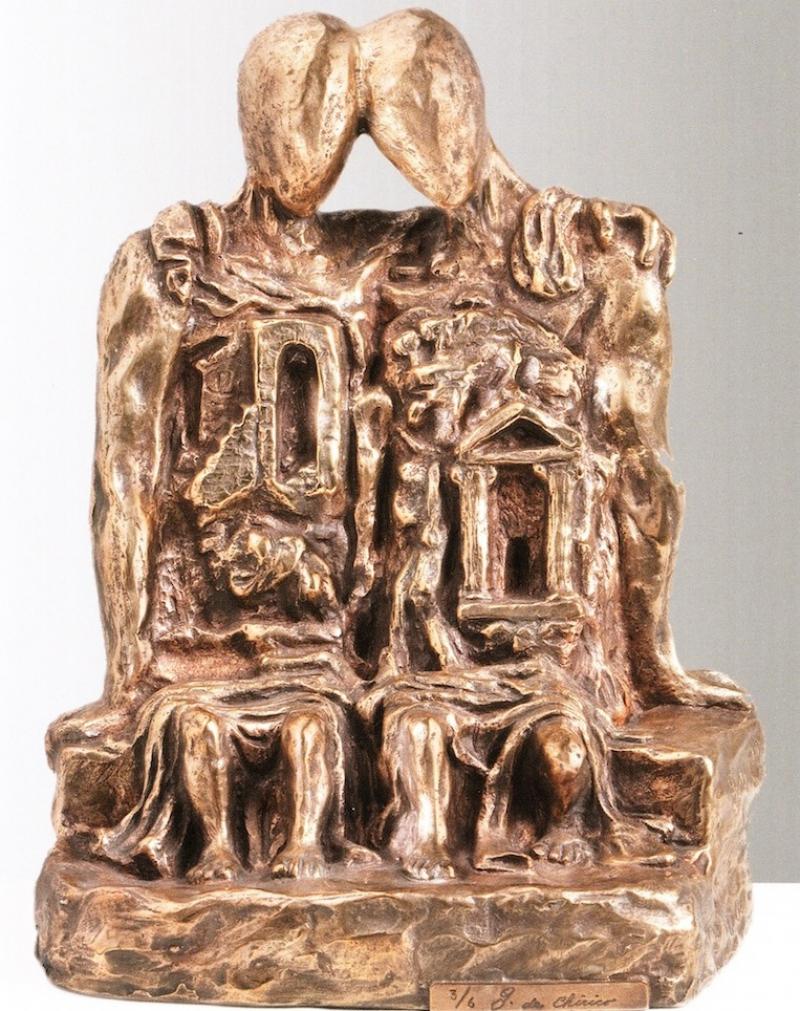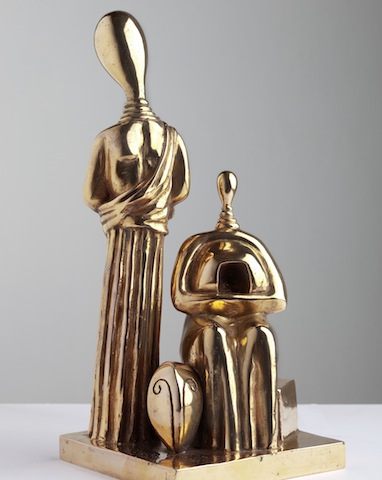Giorgio de Chirico: Myth and Mystery, Estorick Collection | reviews, news & interviews
Giorgio de Chirico: Myth and Mystery, Estorick Collection
Giorgio de Chirico: Myth and Mystery, Estorick Collection
The artist's late work was once dismissed, but is it time for a reassessment?

An exhibition of work by a giant of 20th-century painting cannot reasonably be expected to turn up too many surprises; the most we can usually hope for is a good proportion of lesser-known works to temper the “masterpieces”. To reveal a whole body of work hitherto ignored by art historians is something of a coup, but the Estorick Collection’s new show does just this, introducing over 20 sculptures that will be unknown to all but the most committed fans of Giorgio de Chirico.
Known almost exclusively as a painter, de Chirico (1888-1978) is famous for his series of bizarre but seminal paintings that set out the iconography of Pittura metafisica, using strange juxtapositions, faceless figures and distorted perspectives to fuel a sense of anxiety and estrangement. Metaphysical painting, in particular works like de Chirico’s The Song of Love, 1914, was hugely admired by the Surrealists, and for a time, de Chirico was the toast of the avant-garde.
The iconography of mannequins, automatons and tailors’ dummies is instantly recognisable
Perhaps due to his early years in Greece and his Italian parentage, the classical tradition was never entirely absent from his practice and in 1919, de Chirico appalled the Surrealists by making a series of copies of Old Master paintings. De Chirico appeared to have retreated under the comfort blanket of tradition, and he was ostracised as a reactionary by the avant-garde for whom he had once been a hero. This narrative of de Chirico’s decline has held fast, and his later career, characterised by obsessive reworkings of paintings by Renaissance masters as well as from his own Metaphysical period, has until recently been largely dismissed.
It was during his “decline” that de Chirico began experimenting with sculpture, and the iconography of mannequins, automatons and tailors’ dummies, so familiar from the Metaphysical paintings, is instantly recognisable. Although de Chirico did not begin producing sculpture until the 1930s, the nature of the medium was a longstanding preoccupation; in Horses of the Seashore, 1962-1963, the horses appear too animated to be statues, but too lifeless to be living creatures, the rubble of ancient ruins giving the impression that they have somehow broken free of their sculpted form.

At the root of de Chirico’s eventual abandonment by the avant-garde was the belief that he had dropped modernism in order to embrace classicism. It is perhaps surprising then to find that the overtly classicising sculpture Ippolito (Greek Ephebe in Horseback), 1969, was made in the same year as The Colonials, a silvered bronze that deploys the faceless mannequin heads, distorted limbs and torsos filled with strange objects, so central to Metaphysical iconography. Not only does this exhibition refute the idea that an artist’s career develops chronologically, it also gives some insight into de Chirico’s single-minded, perhaps even pathological, determination to perfect the themes and motifs of his work.
Explore topics
Share this article
more Visual arts
 Fantastic Machine review - photography's story from one camera to 45 billion
Love it or hate it, the photographic image has ensnared us all
Fantastic Machine review - photography's story from one camera to 45 billion
Love it or hate it, the photographic image has ensnared us all
 Yinka Shonibare: Suspended States, Serpentine Gallery review - pure delight
Weighty subject matter treated with the lightest of touch
Yinka Shonibare: Suspended States, Serpentine Gallery review - pure delight
Weighty subject matter treated with the lightest of touch
 Jane Harris: Ellipse, Frac Nouvelle-Aquitaine MÉCA, Bordeaux review - ovals to the fore
Persistence and conviction in the works of the late English painter
Jane Harris: Ellipse, Frac Nouvelle-Aquitaine MÉCA, Bordeaux review - ovals to the fore
Persistence and conviction in the works of the late English painter
 Sargent and Fashion, Tate Britain review - portraiture as a performance
London’s elite posing dressed up to the nines
Sargent and Fashion, Tate Britain review - portraiture as a performance
London’s elite posing dressed up to the nines
 Zineb Sedira: Dreams Have No Titles, Whitechapel Gallery review - a disorientating mix of fact and fiction
An exhibition that begs the question 'What and where is home?'
Zineb Sedira: Dreams Have No Titles, Whitechapel Gallery review - a disorientating mix of fact and fiction
An exhibition that begs the question 'What and where is home?'
 Yoko Ono: Music of the Mind, Tate Modern review - a fitting celebration of the early years
Acknowledgement as a major avant garde artist comes at 90
Yoko Ono: Music of the Mind, Tate Modern review - a fitting celebration of the early years
Acknowledgement as a major avant garde artist comes at 90
 Unravel: The Power and Politics of Textiles in Art, Barbican review - the fabric of dissent
An ambitious exploration of a neglected medium
Unravel: The Power and Politics of Textiles in Art, Barbican review - the fabric of dissent
An ambitious exploration of a neglected medium
 When Forms Come Alive, Hayward Gallery review - how to reduce good art to family fun
Seriously good sculptures presented as little more than playthings or jokes
When Forms Come Alive, Hayward Gallery review - how to reduce good art to family fun
Seriously good sculptures presented as little more than playthings or jokes
 Entangled Pasts 1768-now, Royal Academy review - an institution exploring its racist past
After a long, slow journey from invisibility to agency, black people finally get a look in
Entangled Pasts 1768-now, Royal Academy review - an institution exploring its racist past
After a long, slow journey from invisibility to agency, black people finally get a look in
 Barbara Kruger, Serpentine Gallery review - clever, funny and chilling installations
Exploring the lies, deceptions and hyperbole used to cajole, bully and manipulate us
Barbara Kruger, Serpentine Gallery review - clever, funny and chilling installations
Exploring the lies, deceptions and hyperbole used to cajole, bully and manipulate us
 Richard Dorment: Warhol After Warhol review - beyond criticism
A venerable art critic reflects on the darkest hearts of our aesthetic market
Richard Dorment: Warhol After Warhol review - beyond criticism
A venerable art critic reflects on the darkest hearts of our aesthetic market
 Dineo Seshee Raisibe Bopape: (ka) pheko ye / the dream to come, Kiasma, Helsinki review - psychic archaeology
The South African artist evokes the Finnish landscape in a multisensory installation
Dineo Seshee Raisibe Bopape: (ka) pheko ye / the dream to come, Kiasma, Helsinki review - psychic archaeology
The South African artist evokes the Finnish landscape in a multisensory installation

Add comment